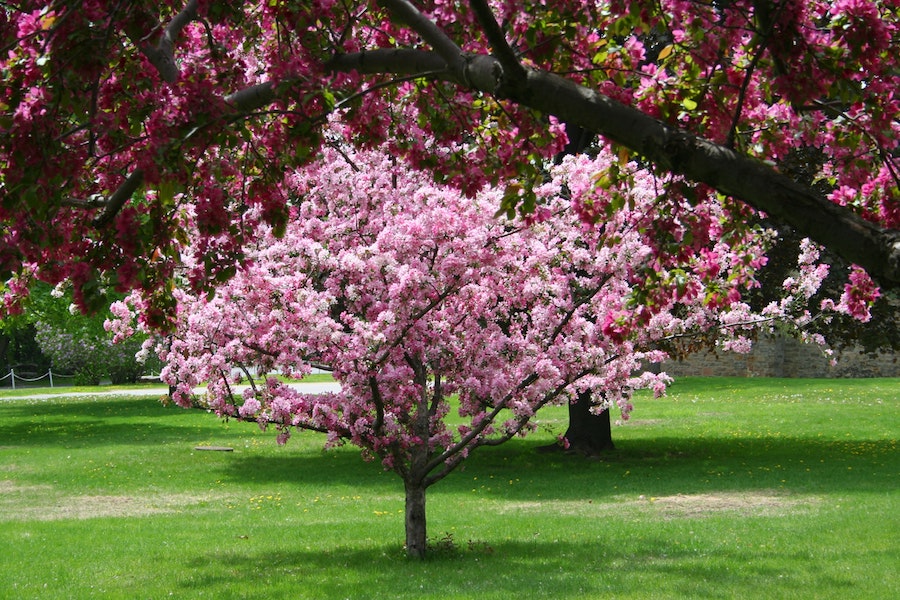5 trees ideal for small outdoor spaces
Small trees are in high demand, with suppliers increasing production in compact varieties – including crab apples, which bear beautiful spring flowers, and Vossii laburnums, with their upright forms and disease-resistant characteristics.
Trees provide structure, screening and shade, as well as colour which continues through the season, creating a sense of enclosure, their height drawing the eye up and out and helping link land with sky – and if you choose wisely, there’s no reason why having a dinky outdoor space should stop you introducing them.
Your tree needs to earn its space in a small garden, so look for one with year-round interest: A tree that blossoms for a week in spring but then looks ordinary for the rest of the year really won’t do.
In really tight spaces, you may be better off with a trimmed and trained plant, either in the ground or in a container, while carefully shaped topiary can also create an eye-catching focal point.
Here are five good examples to consider…
1. Amelanchier

Amalanchiers bear clouds of white flowers
Amelanchiers have featured heavily in garden shows in the past couple of years, as designers have displayed their value as choice trees for confined spaces.
Amelanchier lamarckii (10m x 12m), the snowy Mespilus, is often grown as a multi-stemmed showstopper but can also be trained as a light standard. Starry white flowers cover its branches in spring, at the same time as its bronze foliage is opening, while in autumn the small leaves often turn to fiery red and yellow.
They do best in acid soils, so plant them in ericaceous compost. These tall, slender shrubby trees make great subtle screening.
2. Flowering dogwood

Bracts of Cornus kousa provide eye-catching interest
Flowering dogwoods are long-season stalwarts, their star-shaped blooms appearing in late spring, followed by fantastic leaf colours of reds and oranges in autumn, and strawberry-like fruits which persist into winter.
Good varieties include Cornus kousa (7m x 5m), which bears spreading branches smothered in creamy white blossom in early summer and deep-pink bracts in late spring and orange leaves in autumn, and Cornus mas (5m x 5m), the Cornelian cherry, a small spreading variety which comes into its own in winter when clusters of yellow flowers smother the bare branches.
3. Laburnum x watereri ‘Vossii’

The zingy yellow chains of blooms of Laburnum x watereri’ Vossii’ in early summer
These elegant small trees, which produce long chains of brilliant yellow flowers in May and June, are perfect for training over an arch or pergola when branches are young and pliable.
Gardeners can remove the poisonous seedpods to help improve flowering next year. Just be aware that all parts of the plant are very poisonous, so this is not a child-friendly choice.
They’ll grow to around 8m x 8m and can tolerate poor and shallow soil. Laburnum can also be grown in large tubs, forced early into flower. Arguably the best for this is L. anagyroides var. alschingeri.
4. Crab apple (malus)

Malus ‘Evereste’
Flowering crab apples produce a double whammy of eye-catching blossoms in spring, followed by attractive fruits in autumn.
A good variety is ‘Evereste’ (8m x 8m, but slow-growing), which bears a puff of white and pink fragrant flowers in spring which are a magnet to bees, followed by orange-yellow fruits which can be made into jam.
The slow-growing Japanese crab, Malus Floribunda, is also less vigorous, its horizontal branches covered in crimson buds in the spring, which open to blush-pink and white scented blooms. The advantage of malus is that you can control their size and shape, like a fruiting apple.
5. Acer palmatum (Japanese maple)

Japanese maples are ideal for planting in pots
These stunning stars of the show grow equally well in pots, if you only have a courtyard space and need to keep their size in check, or in the ground to create colour and add structure to a scene.

Acer palmatum ‘Bloodgood’ is a popular choice
Mix a combination in different pots to create a range of stunning contrasting autumn colours, including Acer palmatum ‘Bloodgood’, which bears rich red-purple foliage from spring to autumn, Acer palmatum ‘Sango-kaku’, whose leaves open orange-yellow in spring, and Acer palmatum var. dissectum, whose finely cut mid-green leaves turn golden in autumn.
Plant them in full sun and try to avoid really exposed areas, where their delicate foliage may be damaged by icy winds. If you’re planting them in a container, use compost consisting equal parts of John Innes No. 2 potting compost and a soil-less multipurpose, with plenty of drainage in the base.
The Press Association
Latest posts by The Press Association (see all)
- 5 new books to read this week - November 23, 2024
- 3 easy Mary Berry recipes to make this season - November 22, 2024
- In Pictures: Party stalwart kept New Labour in touch with traditional supporters - November 21, 2024
- 6 easy indoor exercises to try this winter – and why they are good for you - November 19, 2024
- Martin Clunes: I can’t afford to retire – I’ve got too many horses - November 19, 2024





















